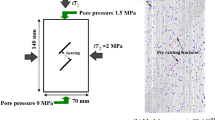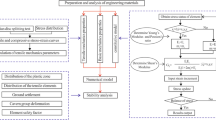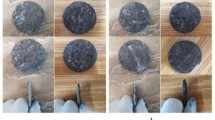Abstract
Reasonable failure paths are crucial in the stability assessment of a highly pressurized gas storage cavern in a rock mass using limit equilibrium analysis. In this study, the fracture patterns in the rock mass around a gas storage cavern are evaluated based on the element-free Galerkin (EFG) method with a cohesive crack model. The proposed analysis method was first validated through scaled-down model testing results before extending to a full-scale problem. Using the current approach, a parametric sensitivity analysis was performed by taking into account the influences of the stress ratio, the depth of the cavern, and the tensile strength of the rock mass. Based on the analysis results obtained, this research showed that the representative failure paths, in which the uplift evaluation is necessary, can be established from the EFG results with careful consideration of crack initiation and the propagation direction. The site having an in situ stress ratio greater than 1.2 is preferred for operation of underground gas storage caverns. By performing the limit equilibrium analyses for stability assessment of the rock mass above the pressurized cavern, we demonstrated that the factor of safety against uplift computed from the failure paths established in this study is higher than or equal to those obtained from analyses with the simplified models in previous studies without considering the influence parameters on the fracture patterns.

















Similar content being viewed by others
References
Anderson UH (1989) Steel lined rock cavern. In: Proceedings of storage of gases in rock cavern, Balkema, Rotterdam, pp 145
Belytschko T, Lu YY, Gu L (1994) Element-free Galerkin methods. Int J Numer Meth Eng 37(2):229–256
Belytschko T, Lu YY, Gu L, Tabbara M (1995) Element-free Galerkin methods for static and dynamic fracture. Int J Solids Struct 32(17–18):2547–2570
Belytschko T, Fleming M (1999) Smoothing enrichment and contact in the element-free Galerkin method. Comput Struct 71(2):173–195
Belytschko T, Tabbara M (1996) Dynamic fracture using element-free Galerkin methods. Int J Numer Methods Eng 39(6):923–938
Bocca P, Carpinteri A, Valente S (1991) Mixed mode fracture of concrete. Int J Solids Struct 27(9):1139–1153
Brandshaug T, Christianson M, Damjanac B (2001) Technical review of the lined rock cavern (LRC) concept and design methodology—mechanical response of rock mass, Technical Report ICG01-2062-1-4. Itasca Consulting Group, Inc.
Dolbow J, Moes N, Belytscko T (2000) Discontinuous enrichment in finite elements with a partition of unity method. Finite Elem Anal Des 36:235–260
Ghaly A, Hanna A (1994) Ultimate pullout resistance of single vertical anchors. Can Geotech J 31(5):661–672
Glamheden R, Curtis P (2006) Excavation of a cavern for high-pressure storage of natural gas. Tunn Undergr Space Technol 21(1):56–67
Hillerborg A, Modéer M, Petersson PE (1976) Analysis of crack formation and crack growth in concrete by means of fracture mechanics and finite elements. Cem Concr Res 6(6):773–781
Japan Gas Association (2008) Development of advanced natural gas storage technology. Ann Rep 2008:3–9
Johansson J (2003) High pressure storage of gas in lined rock caverns-cavern wall design principles. Royal Institute of Technology, Ph.D. thesis, Stockholm
Jongpradist P, Kanhasing P, Youwai, S (2007) FEM analysis for stability assessment against ground uplift of high pressure gas storage cavern. In: Proceeding of the 1st SEATUC symposium, 27–28 February 2007. The Twin Towers, Thailand, pp 74–79
Jongpradist P, Tunsakul J, Kongkitkul W, Fadsiri N, Arangelovski G, Youwai S (2015) High internal pressure induced fracture patterns in rock masses surrounding caverns: experimental study using physical model tests. Eng Geol 197:158–171
KIGAM (Korea Institute of Geoscience and Mineral Resources) (2010) Development of underground energy storage system in lined rock cavern. Ministry of Knowledge Economy, Seoul
Kim HM, Park D, Ryu DW, Song WK (2012) Parametric sensitivity analysis of ground uplift above pressurized underground rock caverns. Eng Geol 135–136:60–65
Kovári K (1993) Basic consideration on storage of compressed natural gas in rock chambers. Rock Mech Rock Eng 26(1):1–27
Littlejohn GS, Bruce DA (1975) Rock anchors—state of the art. Part 1: Design (1). Ground Eng 8(3):25–32
Liu F, Borja RI (2010) Finite deformation formulation for embedded frictional crack with the extended finite element method. Int J Numer Methods Eng 82:773–804
Liu F, Borja RI (2010) Stabilized low-order finite elements for frictional contact with the extended finite element method. Comput Methods Appl Mech Eng 199:2456–2471
Lu M (1998) Finite element analysis of pilot gas storage in rock cavern under high pressure. Eng Geol 49(3–4):353–361
Mansson L, Marion P, Johansson J (2006) Demonstration of the LRC gas storage concept in Sweden. In: World gas conference, Amsterdam, Netherlands, pp 404–420
Melenk JM, Babuska I (1996) The partition of unity finite element method: basic theory and applications. Comput Methods Appl Mech Eng 139:289–314
Park D, Kim HM, Ryu DW, Choi BH, Han KC (2013) Probability-based structural design of lined rock caverns to resist high internal gas pressure. Eng Geol 153:144–151
Sofregaz US Inc (1999) Commercial potential of natural gas storage in lined rock caverns (LRC). Topical report SZUS-0005 DE-AC26-97FT34348-10. U.S. Department of Energy
Soparat P, Nanakorn P (2008) Analysis of anchor bolt pullout in concrete by the element-free Galerkin method. Eng Struct 30:3574–3586
Soparat P, Nanakorn P (2008) Analysis of cohesive crack growth by the element-free Galerkin method. J Mech 24(1):45–54
Tunsakul J, Jongpradist P, Kongkitkul W, Wonglert A, Youwai S (2013) Investigation of failure behavior of continuous rock mass around cavern under high internal pressure. Tunn Undergr Space Technol 34:110–123
Tunsakul J, Jongpradist P, Soparat P, Kongkitkul W, Nanakorn P (2014) Analysis of fracture propagation in a rock mass surrounding a tunnel under high internal pressure by the element free Galerkin method. Comput Geotech 55:78–90
Xu Y, Saigal S (1998) An element free Galerkin formulation for stable crack growth in an elastic solid. Comput Methods Appl Mech Eng 154(3–4):331–343
Zhang G, Li Y, Yang C, Daemen JK (2014) Stability and tightness evaluation of bedded rock salt formations for underground gas/oil storage. Acta Geotech 9:161–179
Acknowledgements
The authors would like to acknowledge the Institutional Research Capability Development grant from Thailand Research Fund (TRF) and King Mongkut’s University of Technology Thonburi (KMUTT). The support from the NRU Project of Thailand, Office of the Higher Education Commission, and that from Rajamangala University of Technology Rattanakosin Wang Klai Kangwon Campus are also acknowledged.
Author information
Authors and Affiliations
Corresponding author
Rights and permissions
About this article
Cite this article
Tunsakul, J., Jongpradist, P., Kim, HM. et al. Evaluation of rock fracture patterns based on the element-free Galerkin method for stability assessment of a highly pressurized gas storage cavern. Acta Geotech. 13, 817–832 (2018). https://doi.org/10.1007/s11440-017-0594-5
Received:
Accepted:
Published:
Issue Date:
DOI: https://doi.org/10.1007/s11440-017-0594-5




